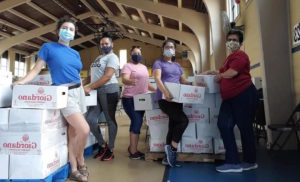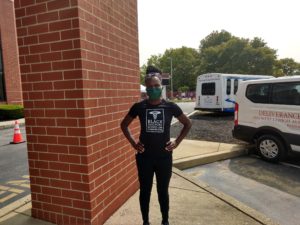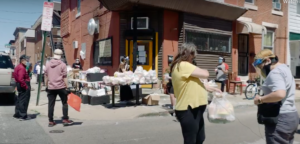One year of COVID-19
 March 11, 2021
Category: Featured, Long, Purpose
March 11, 2021
Category: Featured, Long, Purpose
It has been one year since the World Health Organization declared COVID-19 a global pandemic.
The viral juggernaut has taken more than 2 million lives worldwide to date, nearly 530,000 of them in the United States alone. COVID has wreaked havoc on economies, livelihoods and our collective mental health.
When we started publishing stories about COVID-19, it was hard to find images of the virus to accompany our stories — now there are zillions of gifs and memes featuring the distinctive spiky coronavirus.

When we started this coverage, we worried about who was able to get tested (too few), now we worry about who is able to get vaccinated (also too few).
At the beginning we were publishing instructions on how to make effective homemade masks to get us through without having to purchase one, and by Christmastime we had made masks part of our museum store holiday gift-giving guide.
If there has been one constant throughout our year of coverage, it has been how responsive the nonprofit sector has been in its attempts to meet the rapidly changing and escalating needs in the Philadelphia area.
Here then, the timeline of this COVID year, as we saw it, and what it says about where we’ve been and where we are.
March 2020: Anxiety, shortages and rapid response
One of the first COVID-19 stories we published at Generocity was titled “7 science-based strategies to cope with coronavirus anxiety.” As the pandemic has progressed, we’ve kept focusing attention on mental health and wellbeing, of course, but it is interesting to be reminded that our collective emotional tenor has evolved from the anxiety we were feeling back then. Remember the panicked run on toilet paper and hand sanitizer that left grocery store shelf bare? Yeah.
Nonprofit leaders urged us to be both smart and kind; foundations and rapidly formed funding coalitions responded to the crisis with astonishing alacrity; congregate shelters quickly modified operations and processes to reduce risks; and nonprofits, municipal governments, community and faith organizations seriously ramped up emergency food distribution efforts.
Also this month, we tracked how nonprofit service providers had to lay off or furlough staff, and how employees of the PA’s Department of Human Services — newly categorized as essential workers — felt the state was playing fast and loose with their health and safety in order to keep operational.
April: Sheltering in place, the rise of mutual aid and the prospect of sewer nasties
We opened the month with a piece about how to successfully shelter in place with pointers offered by Carmela Apolonio Hernández who, having lived in sanctuary in a church with her children for more than two years, was an expert in how to survive an extended period with a seriously circumscribed day-to-day. [Editor’s note: Apolonio Hernández was recently able to come out of sanctuary.]
 Despite foundations and funds continuing to pour money into nonprofits and community organizations offering emergency relief to beleaguered residents, people throughout the area were desperate and in need. Mutual aid organizations formed to meet the need in neighborhoods, providing a lifeline for many.
Despite foundations and funds continuing to pour money into nonprofits and community organizations offering emergency relief to beleaguered residents, people throughout the area were desperate and in need. Mutual aid organizations formed to meet the need in neighborhoods, providing a lifeline for many.
Mayor Jim Kenney told Philadelphians in an open letter, that while the streets were quiet, the spirit of the city was undimmed. Frontline healthcare providers asked for help in dealing with the dire PPE shortage, and we began to understand how seriously the digital divide and systemic racial inequities would play into pandemic impacts on the Black community.
And, as if a global pandemic weren’t apocalyptic enough, the Philadelphia Water Department warned us that if we didn’t stop flushing wipes (and throwing our gloves and masks on the ground where they would wash into storm drains) we were going to create fatty icebergs (“fatbergs”) in the sewer system that would create blockages requiring emergency repairs and extended street closures. Good times.
May: Refining work from home routines, the unkindness of budget cuts, and learning how to grieve
Foundations and funds were still chugging along with emergency relief to nonprofits providing much-needed services (see why I called nonprofit response the constant in our year?), while the City proposed a bleakly reconfigured budget. Arts organizations, seriously impacted by the proposed budget cuts, reminded us that the arts could be part of the solution, university teaching assistants turned to GoFundMe for help when universities shut down, and we marked the fun ways some nonprofits pivoted to virtual.
Meanwhile, our pets became our coworkers, and we wondered whether we had to wear pants as we worked from home. For those of us who were unemployed, trying to secure unemployment benefits became our fulltime job.
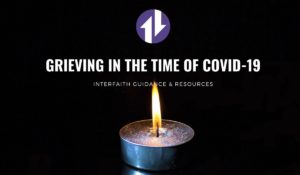 And, undergirding it all, were COVID deaths.
And, undergirding it all, were COVID deaths.
How do you grieve if the pandemic keeps you from gathering with family and loved ones? How do you get through loss if the processes meant to help you are unavailable? That was (and still is) the reality during COVID — so we asked Philadelphia faith leaders to help us learn new ways to grieve.
June: How to protest during a pandemic
The same racial injustices and inequities that undergirded the summer uprisings undergird the immediate and longer term impacts of the pandemic.
Educators wondered how to teach with the dual, entwined crises challenging the usual pedagogy, people thought about adopting local businesses and about how to stay safe from contagion while protesting.
Community health and justice promotores provided crucial services to immigrant communities unable to access aid because of documentation status, and a community nonprofit called for the abolishment of prisons for their part in a racist criminal justice system and their grim reality as COVID petri dishes.
A giving circle formed to help Black women-led organizations grappling with COVID, and big private foundations pledged to increase their grantmaking by a billion to meet coronavirus needs.
Oh, and on a more personal level, people grappled with feelings of isolation, loneliness and the stress that comes from being in situations over which they have no control.
July: Who pays, thoughts about reopening schools, addressing health inequities in the African American community
July started with an op-ed calling for the federal government to cover pandemic costs incurred by local and state governments, and call for the federal stimulus to cover hazard pay, paid leave and more.
A local educator offered six things to consider before reopening schools, and we published a piece that looked at what other countries did before opening schools — and what the U.S. could learn from them.
And a local organization founded more than three decades ago to address the AIDS epidemic in the African American community, pointed to how, with inequities at the root, COVID mirrors the AIDS epidemic’s impact on the Black community.
August: Food yes, housing no
We published fewer COVID-related stories in August than in any of the preceding months, but two of our TRACE (Toward Response and Community Equity) project stories centered on philanthropic responses to the pandemic since its start. One noted that the pandemic had boosted food-related philanthropy; the other that despite urgent need, the philanthropic sector was absent from the rental relief funding space.
September: Virtual schooling, underserved communities, the mental health of nonprofit staff
Unsurprisingly, going to school during COVID was at the center of this month’s coverage. Students’ digital access, the challenge of being a working mom with children in virtual schooling, and tips for making virtual schooling successful were al stories we ran this month.
Our first interview with Dr. Ala Stanford of the Black Doctor’s COVID Consortium ran this month, after a COVID outbreak at Temple University. Stanford formed the consortium after realizing that without her intervention, the needs of lower-income Black Philadelphians would get short shrift. A similar understanding prompted Hunting Park grassroots groups to reach out to and interact with their neighbors and community members via tech.
On the mental health front, stories this month focused on the importance of self-care in response to trauma, and the very real mental health toll on staffers at nonprofits on the front lines of serving those impacted by COVID needs.
October: Good things happen in Philadelphia
Our October COVID coverage starts on a high note — with the story of how the pandemic empowered a partnership to provide relief to businesses in the North Broad commercial corridor.
We also published a look at how the $40 million in COVID relief to date from foundations had been distributed; another story that gauged how nonprofits themselves felt the pandemic recovery efforts were going, and a third in which funders were asked to assess if we have advanced from relief to recovery.
Child care and early education and addressing the COVID-precipitated rental crisis in the city were all part of the October coverage.
November: COVID silenced Domestic violence victims
The central piece in this month’s COVID coverage illuminated how an alarming drop in calls to the Philadelphia Domestic Violence Hotline during the pandemic could be attributed to COVID isolation and being trapped with abusers 24/7, which led to the difficulty in reaching out for help.
In collaboration with the Indonesian Lantern, we looked at the impact of COVID-related deaths on Philly’s small but dynamic Indonesian community (a later article in the collaboration dove into COVID’s impact on the community’s restaurants).
We also looked at the ways nonprofits in the suburbs had pivoted after COVID; the sudden lack of volunteers overall and that impact on organizations doing food distributions during the holidays; and finally published a look at how COVID has sharpened the need for impact development in Black and brown communities.
December: The end of pandemic support and relief, and vaccines in the pipeline
We covered a number of COVID-related stories during this month, but two best encapsulated the questions on everyone’s mind: “when and how will I be protected healthwise,” and “when and how will I be unprotected safety-net-wise.”
The first piece outlined the supply chain and distribution challenges of the COVID vaccines (which were approved Dec. 11 and 18). The other article looked at all the COVID-related relief programs that were set to expire Dec. 31.
January 2021: Questions, questions, questions about the vaccine
We started with a stress-busting piece on how to outsmart COVID fears, but soon after everything was vaccine related: Who it will protect and who can get it; the whys and wherefores (and how to address) vaccine hesitancy in the Black and Latinx communities; Philly’s online portal and distribution plan and … the City’s almost instantly disastrous choice to make Philly Fighting COVID the nonprofit to coordinate its mass vaccination plan.
February: Erosion of trust
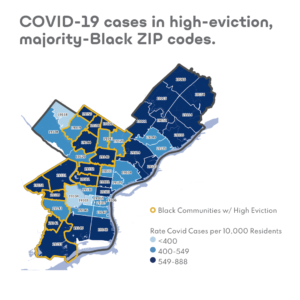 After the Philly Fighting COVID debacle some nonprofits felt an overall erosion of public trust was in the offing. Non-healthcare nonprofits scrambled to help communities overcome the limitations of eviction assistance or unmanageable energy burdens.
After the Philly Fighting COVID debacle some nonprofits felt an overall erosion of public trust was in the offing. Non-healthcare nonprofits scrambled to help communities overcome the limitations of eviction assistance or unmanageable energy burdens.
We also celebrated the cultural institutions that, amid pandemic, had found ways to reach out to make programming more accessible to all.
And a report confirmed what some had known and/or believed all along: Race, housing insecurity, and COVID-19 are all connected.
March: Justice and mental health
We started the month by asking whatever happened to the North Philadelphia Health Enterprise Zone? Had the HEZ become what it set out to be, the effects of the pandemic on Black and brown communities might have been quite different.
The question (and answer) of that article are related to the disparities that have been part of the pandemic response from the first, and that manifests in another COVID-related story with a question as its headline: What does the high vaccination rates among white America say about justice?
An article we published two days ago returns to the topic of mental health during COVID. It is interesting to note how we started with an article about anxiety and panic back in March 2020, which evolved into articles about stress, loneliness, isolation, and grief, to land us here, on this article — this bookend — which says that what some of us are experiencing is not a mental crisis so much as pure anguish. And while anguish is hard, and uncomfortable, it is not disordered,
Instead, the author suggests, it is an altogether ordinary response to an adverse situation. A year of adverse situations.
Here’s hoping that come March 2022, we will be long over the anguish.
Project
COVID-19 coverageTrending News









